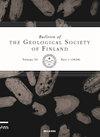重新考察了苏门涅米拉帕基花岗岩杂岩的年代学
IF 1.3
4区 地球科学
Q2 GEOLOGY
引用次数: 15
摘要
根据Pb/U的点比误差,讨论了芬兰东南部Wiborg岩基北侧晚古元古代Suomenniemi rapakivi花岗岩杂岩的多粒同位素稀释、二次离子探针锆石U-Pb和整体岩石Rb-Sr同位素稀释资料,并提出了87Rb衰变常数λ87的新值。苏梅尼米岩体主要过铝质花岗岩分选系列的角闪石花岗岩和黑云母花岗岩U-Pb锆石数据表明,其结晶时间为1644 ~ 1640 Ma,优选年龄为1644±4 Ma。横切角闪石-斜辉石-费雅长岩花岗岩可能更年轻一些,石英-长石斑岩岩脉(1634±4 Ma)也可能更年轻一些,它既切割了主要的花岗岩系列,也切割了苏梅尼米岩基的变质西芬系岩石。Rämö(1999)重新计算了该岩基主要花岗岩系列的全岩Rb-Sr数据,误差年龄为1635±10 Ma和1630±10 Ma,岩浆Sr/Sri为0.7062±0.0024。这一较高的初始比值表明,该岩基的花岗岩中存在主要的元古代地壳源成分。基底的主要花岗岩系列可能相对迅速地冷却到Rb-Sr同位素系统的关闭温度以下,随后几乎没有次固体调整。基岩的三个独立的硅质岩浆相(主花岗岩系列、角闪石-斜辉石-费雅长岩花岗岩和石英-长石斑岩岩脉)可能都位于芬兰东南部的拉帕基维花岗岩主体体(Wiborg基岩本身)之前。因此,Suomenniemi岩基代表了经典维博格岩基的早期岩浆前兆,它的位置明显早于等温线的大规模上升,等温线的上升和结晶形成了维博格岩基系统的主体。本文章由计算机程序翻译,如有差异,请以英文原文为准。
Geochronology of the Suomenniemi rapakivi granite complex revisited
Multi-grain isotope dilution and secondary ion microprobe zircon U-Pb as well as wholerock Rb-Sr isotope dilution data on the late Paleoproterozoic Suomenniemi rapakivi granite complex (exposed on the northern flank of the Wiborg batholith in southeastern Finland) are discussed in the light of point-specific errors on Pb/U and proposed new values of the decay constant of 87Rb, λ87. U-Pb zircon data on hornblende granite and biotite granite of the main metaluminous-marginally peraluminous granite fractionation series of the Suomenniemi batholith indicate crystallization in the 1644-1640 Ma range, with a preferred age at 1644±4 Ma. A cross-cutting hornblende-clinopyroxene-fayalite granite is probably slightly younger, as are quartz-feldspar porphyry dikes (1634±4 Ma) that cut both the main granite series and the metamorphic Svecofennian country rocks of the Suomenniemi batholith. Recalculation of whole-rock Rb-Sr data published on the main granite series of the batholith by Rämö (1999) implies errorchron ages of 1635±10 Ma and 1630±10 Ma and a magmatic Sr/Sri of 0.7062±0.0024. This relatively high initial ratio is indicative of a major Proterozoic crustal source component in the granites of the batholith. The main granite series of the batholith probably cooled relatively rapidly to and below the closure temperature of the Rb-Sr isotope system, with little subsequent subsolidus adjustment. The three discrete silicic magmatic phases of the batholith (the main granite series, the hornblende-clinopyroxene-fayalite granite, and the quartz-feldspar porphyry dikes) were all probably emplaced before the main volume of rapakivi granite (the Wiborg batholith proper) in southeastern Finland. The Suomenniemi batholith thus represents an early magmatic precursor to the classic Wiborg batholith and was emplaced clearly before the massive rise of isotherms associated with the ascent and crystallization of the magmas that formed the bulk of the Wiborg batholith system.
求助全文
通过发布文献求助,成功后即可免费获取论文全文。
去求助
来源期刊
CiteScore
1.30
自引率
0.00%
发文量
5
审稿时长
>12 weeks
期刊介绍:
Bulletin of the Geological Society of Finland (BGSF) publishes research articles and short communications in all branches of geosciences. Contributions from outside Finland are welcome, provided that they contain material relevant to Finnish geology or are of general interest.

 求助内容:
求助内容: 应助结果提醒方式:
应助结果提醒方式:


